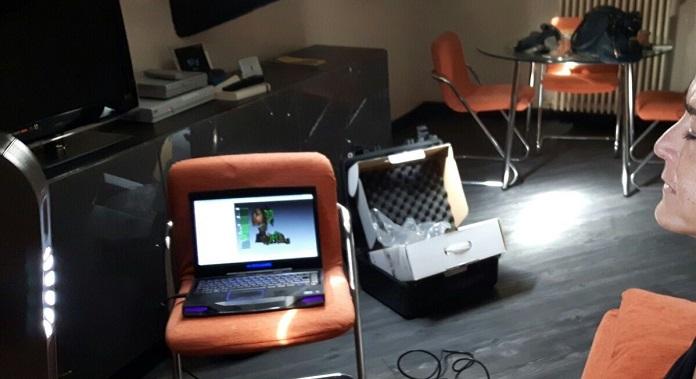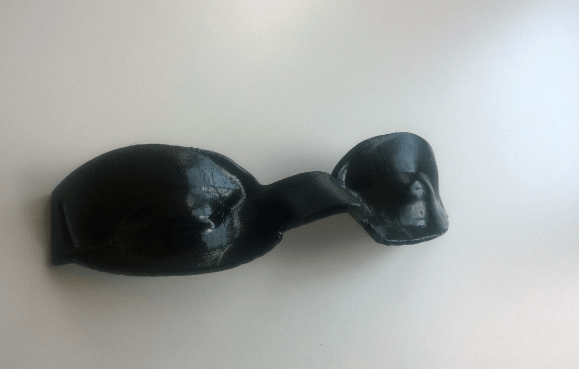 One of the great, and at times life-saving, qualities of 3D printing is its various applications in the medical field. Examples include a young Chinese girl who is able to eat and speak thanks to a 3D printed medical model of her fused jaw; this 3D printed medical model of a spleen, and the 3D printed surgical guides used in a revision scoliosis surgery. Recently Artec 3D completed a case study with Italian company Digital Maison, where they used 3D scanning and printing to help sleep come a little easier for people who suffer from Graves’ disease. The disease often causes the eye to protrude as a symptom (called exophthalmos), which makes it nearly impossible for patients to sleep, so the two companies created a customized eye mask.
One of the great, and at times life-saving, qualities of 3D printing is its various applications in the medical field. Examples include a young Chinese girl who is able to eat and speak thanks to a 3D printed medical model of her fused jaw; this 3D printed medical model of a spleen, and the 3D printed surgical guides used in a revision scoliosis surgery. Recently Artec 3D completed a case study with Italian company Digital Maison, where they used 3D scanning and printing to help sleep come a little easier for people who suffer from Graves’ disease. The disease often causes the eye to protrude as a symptom (called exophthalmos), which makes it nearly impossible for patients to sleep, so the two companies created a customized eye mask.
The bulging immovability of the eye can result in a narrowing field of vision, among other problems, for those who have Graves’ disease. Treatment usually starts with drugs and hormone therapy, and then surgery. Unfortunately, surgery does not always fix the issue, and can actually damage the elevating muscle of the upper eyelid, further impeding the patient from closing their eye, which is especially difficult when they are trying to sleep.
 This happened with a 48-year-old female patient who, over a year post-surgery, started to suffer from a sleep disorder, and no sleeping aids (masks, pads, etc.) could offer her any relief. That’s when 3D scanning and printing service provider Digital Maison was contracted to develop a customized eye mask for the same patient.
This happened with a 48-year-old female patient who, over a year post-surgery, started to suffer from a sleep disorder, and no sleeping aids (masks, pads, etc.) could offer her any relief. That’s when 3D scanning and printing service provider Digital Maison was contracted to develop a customized eye mask for the same patient.
Digital Maison, whose goal is to deliver rapid solutions with low-cost techniques, had previously designed a special shoe for a patient with severe foot deformation using a scanner, fast modeling in Rhinoceros, and rapid prototyping on a Zprinter. This time they partnered with Artec 3D for the job, utilizing one of their lightweight handheld scanners.
“For this project we used Artec Eva, the only scanner for small to medium-sized objects capable of capturing surfaces in detail with extreme ease of use and handling,” says Paolo Gianolio, owner of Digital Maison. “The scanner’s portability has allowed me to scan directly at the patient’s house, which was a psychological benefit.”
A few minutes of scanning and data processing in Artec Studio yielded a precise, textured 3D image of the patient’s face. Its measurement tool enabled Gianolio to reveal remarkable deviations in the facial shape, depending on the patient’s position: the skin on the softest parts of the face, primarily the cheeks, can move up to 5mm if the patient goes from lying to sitting.
“When the final purpose of a project is to develop a device that must fit the face perfectly, like in this case where a sleeping mask needed to be made, it is fundamental to avoid initial error,” explains Gianolio. “It was obvious to me that I needed to work with the scan of the face in the horizontal position. Nevertheless, it was very interesting to compare the two scans in Artec Studio and see the differences in height.”
 The blue color on this scan indicates areas where the skin is set back in the lying position, compared against the sitting position. Using surface modeling in Rhinoceros 5 on the 3D mesh, Gianolio designed a 3D model of the mask. The orthopedic appliance perfectly replicated the facial surface, ensuring the blocking of light and the closing of the eyelids while asleep.
The blue color on this scan indicates areas where the skin is set back in the lying position, compared against the sitting position. Using surface modeling in Rhinoceros 5 on the 3D mesh, Gianolio designed a 3D model of the mask. The orthopedic appliance perfectly replicated the facial surface, ensuring the blocking of light and the closing of the eyelids while asleep.
The final model had several material trials with fused deposition modeling on a DeltaWASP 3D printer. Semi-rigid material Bioflex was the winner, able to guarantee a tight fit and a high level of comfort.
“This project, meant to solve a particular patient’s problem, can be applied in similar cases where patients suffer from the same kind of disorder,” says Gianolio. “The scanner can help produce a perfectly personalized device for just about any medical purpose.”
This is just the latest testimony that 3D printing and scanning can help create relief for those people suffering from medical afflictions that may not be as widely known, who are in need of custom solutions. Discuss in the Digital Maison forum at 3DPB.com.
Subscribe to Our Email Newsletter
Stay up-to-date on all the latest news from the 3D printing industry and receive information and offers from third party vendors.
You May Also Like
Precision at the Microscale: UK Researchers Advance Medical Devices with BMF’s 3D Printing Tech
University of Nottingham researchers are using Boston Micro Fabrication‘s (BMF) 3D printing technology to develop medical devices that improve compatibility with human tissue. Funded by a UK grant, this project...
3D Printing Webinar and Event Roundup: April 21, 2024
It’s another busy week of webinars and events, starting with Hannover Messe in Germany and continuing with Metalcasting Congress, Chinaplas, TechBlick’s Innovation Festival, and more. Stratasys continues its advanced training...
3D Printing Webinar and Event Roundup: March 17, 2024
It’s another busy week of webinars and events, including SALMED 2024 and AM Forum in Berlin. Stratasys continues its in-person training and is offering two webinars, ASTM is holding a...
3D Printed Micro Antenna is 15% Smaller and 6X Lighter
Horizon Microtechnologies has achieved success in creating a high-frequency D-Band horn antenna through micro 3D printing. However, this achievement did not rely solely on 3D printing; it involved a combination...































